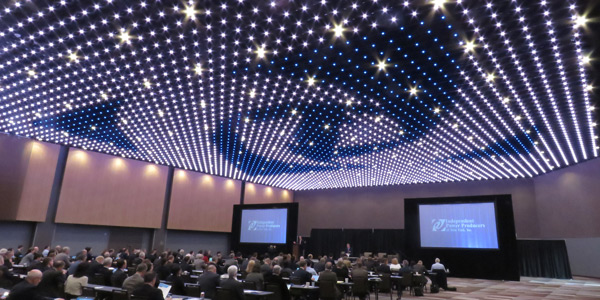ALBANY, N.Y. — About 200 industry stakeholders and state and NYISO officials discussed carbon policy, zero-emission credits, and other pressing and contentious issues at the Independent Power Producers of New York’s 31st Annual Spring Conference last week. Here’s some of what we heard.
New Venue, Tighter Security

This year’s conference was held at the new Albany Capital Center. IPPNY CEO Gavin Donohue is chairman of the Albany Convention Center Authority, which built the $78 million project a block from the state capitol.
Event organizers ordered tighter security than in years past. No one without a registration badge was allowed near the event.
“You know what happened at the last conference,” recounted Donohue, referring to the May 2016 event at the Desmond Hotel, when anti-pipeline protesters took over the stage as then-FERC Chair Norman Bay was speaking.
Energy Policy Under Trump
In a panel on energy policy under President Trump, attorney Steven Croley, a partner with Latham & Watkins who served as general counsel for the Department of Energy under President Barack Obama, led the audience in a “thought experiment” comparing Trump’s energy policy with that of a fictional third Obama term.
Croley said Trump will have a smaller impact than some critics fear, calling the policy differences between the two administrations “susceptible to exaggeration,” Croley said.
For example, he said the scale of LNG exports will be driven by world demand, not any new federal policy.
Neither Trump nor Obama would back federal funding of utility-scale solar projects. The Obama administration funded five such projects, but the falling prices of solar technology made additional federal support unnecessary, he said.
Croley acknowledged that Trump has substantial discretion over how aggressively to enforce existing environmental rules but said that states or environmental groups will likely sue if they believe Trump’s EPA is ignoring major violations.
“[Non-governmental organizations], states [and] state regulators are all important drivers of national policy too. They will fill what is perceived to be a regulatory gap or regulatory inaction to some extent,” he said. “Every White House will create its antibodies. Believe me, that’s how it works.”
Indeed, Kit Kennedy, director of the energy and transportation program for the Natural Resources Defense Council, said her organization has increased its litigation team, which has filed 10 lawsuits against Trump’s efforts to roll back environmental policies. She said the organization is also increasingly looking to state and local governments for leadership.
She was more alarmed than Croley, saying “what the president says and does really matters.”
“We’re seeing an onslaught on bedrock environmental safeguards and laws from President Trump today that we’ve never seen before,” she said. “The situation is fundamentally different” from the Reagan and Bush administrations.
Kennedy engaged in a more vigorous debate with James Taylor, an adviser to the presidential campaign of Energy Secretary Rick Perry and president of the Spark of Freedom Foundation, which promotes natural gas, hydro and nuclear power as “affordable” and “environmentally friendly” sources.
“Renewable is not synonymous with green,” Taylor said, citing the environmental impact of mining for rare earth minerals used in solar panels — which he said is worse than uranium mining.
“Wind turbines kill 1.5 million birds and bats each and every year in this country, including many endangered and protected species. It also requires hundreds of square miles of wind turbines to replace a single conventional power plant. For conservationists, that should trouble us.”
He said federal policy should be based on “full spectrum” environmental impact analyses “that [go] beyond the renewable and non-renewable definition and looks beyond carbon dioxide emissions.”
Problems with New Demand Curve

IPPNY Chair John Reese, senior vice president of Eastern Generation, celebrated the completion of NYISO’s demand curve reset but criticized FERC’s decision to not include the costs of environmental controls for the proxy upstate unit.
“It takes about two years to go through that process and lots of pain and suffering and gnashing of teeth. I think IPPNY did a great job in representing the needs of generators and what it takes to get market investment,” he said.
But he said FERC erred in its January order, which rejected requests by IPPNY and the ISO to assume selective catalytic reduction (SCR) emissions controls for the proxy unit for zones C and F.
In its prior reset, NYISO proposed that the New York Control Area peaking plant operate under an annual operating hours limit in lieu of installing SCR. FERC said that assumption still holds, despite the ISO’s contention that peakers without the controls risk not obtaining necessary air permits. FERC rejected as “speculative” IPPNY’s contention that the state’s Siting Board is likely to require tougher controls in the future. (See FERC OKs NYISO Demand Curve Reset.)
“If you’ve done business in New York — if you have developed projects — to imagine that you could build a fossil generator in upstate New York without State of New York controls is just foolishness,” Reese said. “It just cannot be done.”
IPPNY filed a rehearing request on the issue in February (ER17-386).








